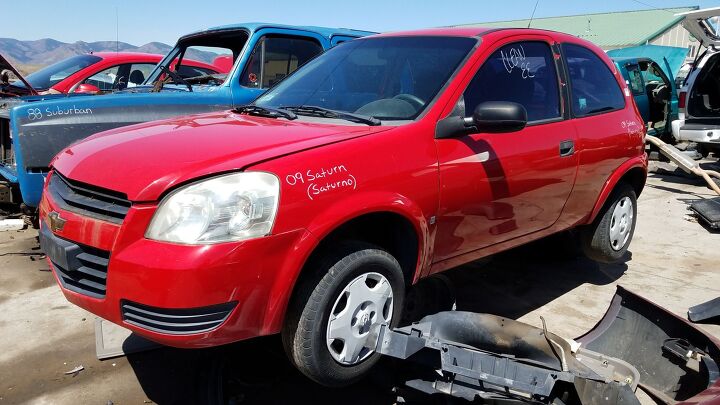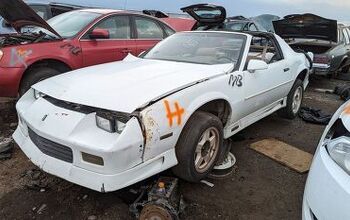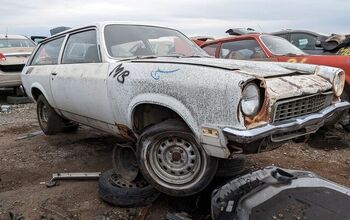Junkyard Find: 2009 Chevrolet Chevy

In all of my 35 years of exploring junkyards in the western United States, I had never found a Mexican-built, Mexican-market car until a few weeks ago, when I spotted this General Motors de México-manufactured 2009 Opel Corsa in a Denver-area self-service wrecking yard.
Chevrolet sold a car called the Chevy II for the 1961 through 1968 model years (after which the name of the top trim level, Nova, became the car’s name for the remainder of its production run), but this is the only genuine Chevy ever made.
These cars were built at GM’s Ramos Arizpe plant, where Sonics and Equinoxes and Cruzes roll off the assembly line today.
There are Chihuahua state registration stickers on the car, and it seems to be in fairly good condition. How did it end its days in a wrecking yard 875 miles to the north, in a country in which no member of the Corsa family was ever sold legally? I don’t know the rules about visitors bringing Mexico-plated cars across the border for business or vacation, though I have seen plenty of such cars in American border towns; perhaps this one overstayed its travel permit and got towed away and impounded after its owners took a trip to Colorado.
I believe this is a 1.2-liter O-series Opel engine, rated at 79 horsepower.
Five-speed manual transmission, of course, because this car was not made for soft, two-pedal Norteamericanos.
I thought about buying the radio, because it would be somewhat cool to have a genuine CHEVY-badged CD player in my Civic, but I passed on this opportunity (mostly because the dash harness connector was buried enough to be a hassle to cut out of the car).
The last year for the Chevrolet Chevy was 2011, after which this European-designed GM econobox was replaced by a Korean-designed GM econobox in the Mexican market.
But that wasn’t the end of the line for this version of the Opel Corsa; you can buy one (badged as a Chevrolet Sail) in China to this day.

Murilee Martin is the pen name of Phil Greden, a writer who has lived in Minnesota, California, Georgia and (now) Colorado. He has toiled at copywriting, technical writing, junkmail writing, fiction writing and now automotive writing. He has owned many terrible vehicles and some good ones. He spends a great deal of time in self-service junkyards. These days, he writes for publications including Autoweek, Autoblog, Hagerty, The Truth About Cars and Capital One.
More by Murilee Martin
Latest Car Reviews
Read moreLatest Product Reviews
Read moreRecent Comments
- Jalop1991 In a manner similar to PHEV being the correct answer, I declare RPVs to be the correct answer here.We're doing it with certain aircraft; why not with cars on the ground, using hardware and tools like Telsa's "FSD" or GM's "SuperCruise" as the base?Take the local Uber driver out of the car, and put him in a professional centralized environment from where he drives me around. The system and the individual car can have awareness as well as gates, but he's responsible for the driving.Put the tech into my car, and let me buy it as needed. I need someone else to drive me home; hit the button and voila, I've hired a driver for the moment. I don't want to drive 11 hours to my vacation spot; hire the remote pilot for that. When I get there, I have my car and he's still at his normal location, piloting cars for other people.The system would allow for driver rest period, like what's required for truckers, so I might end up with multiple people driving me to the coast. I don't care. And they don't have to be physically with me, therefore they can be way cheaper.Charge taxi-type per-mile rates. For long drives, offer per-trip rates. Offer subscriptions, including miles/hours. Whatever.(And for grins, dress the remote pilots all as Johnnie.)Start this out with big rigs. Take the trucker away from the long haul driving, and let him be there for emergencies and the short haul parts of the trip.And in a manner similar to PHEVs being discredited, I fully expect to be razzed for this brilliant idea (not unlike how Alan Kay wasn't recognized until many many years later for his Dynabook vision).
- B-BodyBuick84 Not afraid of AV's as I highly doubt they will ever be %100 viable for our roads. Stop-and-go downtown city or rush hour highway traffic? I can see that, but otherwise there's simply too many variables. Bad weather conditions, faded road lines or markings, reflective surfaces with glare, etc. There's also the issue of cultural norms. About a decade ago there was actually an online test called 'The Morality Machine' one could do online where you were in control of an AV and choose what action to take when a crash was inevitable. I think something like 2.5 million people across the world participated? For example, do you hit and most likely kill the elderly couple strolling across the crosswalk or crash the vehicle into a cement barrier and almost certainly cause the death of the vehicle occupants? What if it's a parent and child? In N. America 98% of people choose to hit the elderly couple and save themselves while in Asia, the exact opposite happened where 98% choose to hit the parent and child. Why? Cultural differences. Asia puts a lot of emphasis on respecting their elderly while N. America has a culture of 'save/ protect the children'. Are these AV's going to respect that culture? Is a VW Jetta or Buick Envision AV going to have different programming depending on whether it's sold in Canada or Taiwan? how's that going to effect legislation and legal battles when a crash inevitibly does happen? These are the true barriers to mass AV adoption, and in the 10 years since that test came out, there has been zero answers or progress on this matter. So no, I'm not afraid of AV's simply because with the exception of a few specific situations, most avenues are going to prove to be a dead-end for automakers.
- Mike Bradley Autonomous cars were developed in Silicon Valley. For new products there, the standard business plan is to put a barely-functioning product on the market right away and wait for the early-adopter customers to find the flaws. That's exactly what's happened. Detroit's plan is pretty much the opposite, but Detroit isn't developing this product. That's why dealers, for instance, haven't been trained in the cars.
- Dartman https://apnews.com/article/artificial-intelligence-fighter-jets-air-force-6a1100c96a73ca9b7f41cbd6a2753fdaAutonomous/Ai is here now. The question is implementation and acceptance.
- FreedMike If Dodge were smart - and I don't think they are - they'd spend their money refreshing and reworking the Durango (which I think is entering model year 3,221), versus going down the same "stuff 'em full of motor and give 'em cool new paint options" path. That's the approach they used with the Charger and Challenger, and both those models are dead. The Durango is still a strong product in a strong market; why not keep it fresher?


















































Comments
Join the conversation
This engine doesn't belong to the GM Family 0 –as Mr. Murilee Martin states–, but probably to the GM Family II, which is old –not older than the Iron Duke nevertheless–. In this case this F II is a single OHC and it has sequential fuel injection (that's why the "SFI" in the head cover). It cranked out more than 100 hp according to GM of Mexico (I don't recall the exact power), supposedly SAE homologated. If this “genuine” Chevy has ran 60,000 kilometers (37,300 miles) it's time to –no pun intended– to change the timming belt, which is pricey here in Mexico, and expensive as hell there in the USA –because of labour costs–. If it's true that here in Mexico people use crappy Chevys as daily drivers that are better suited for the cruncher for sure, that Chihuahuan Chevy could be a valuable car down south the border. As I stumbled upon this junkyard find of this clean Chevy, my best guess is the owner in the USA avoided to do the expensive timming belt change, and, as this engine is an interference type unit, no guy smart enough would dare to keep this engine operating beyond 60,000 kilometers.
Hello, I am the owner of a Chevy, I am from Chihuahua Mexico, if you want to see some photos send me a message It is a very good car for the city and the road It is a 1.6-liter engine with 100 horsepower, on saturn is only the agency that sells the car not the brand, Regards